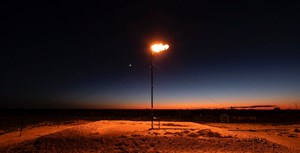EDF claims more regulation can cut Permian basin flaring
(Bloomberg) --As much as 40% of the natural gas that’s expected to be flared in the Permian Basin in 2025 could be avoided at no cost to drillers if regulators abandoned their hands-off approach to the controversial practice, according to a report.
The vast majority of that would come from curbing so-called routine flaring, which is driven mainly by companies’ failure to adequately plan for the associated gas that’s produced alongside oil, the analysis by Rystad Energy on behalf of the Environmental Defense Fund shows.
Its findings run counter to arguments put forward by the state’s powerful oil regulator, which has said the cost of stricter policies would spur producers to shut in their wells, thereby wasting natural resources. Flaring, which plunged in 2020 as the pandemic forced shale producers to curtail output, is set to rebound as oil prices recover.
“Coming at this initially, we expected there would be potentially large challenges for the industry to overcome from a financial perspective,” said Mike McCormick, a principal at Rystad. “A lot of this is avoidable.”
Flaring is the process by which oil and gas companies burn off natural gas, eliminating most of the methane so carbon dioxide is the dominant greenhouse gas emitted into the atmosphere. It’s preferred to releasing gas directly because methane is 80 times more potent than carbon dioxide over its first two decades in the atmosphere.
But the practice has increasingly garnered criticism, including from major investors and even some producers. Surveys conducted by EDF have shown that roughly 1 in 10 flare sites are malfunctioning or unlit, meaning flaring contributes far more to the Permian’s overall methane emissions than originally thought. European supermajors BP Plc and Royal Dutch Shell Plc last year called on the Texas Railroad Commission, as the regulator is known, to “support an ambition of zero routine flaring in Texas.”
The Railroad Commission met Tuesday, when the three Republican commissioners were faced with a list of 175 flaring requests. BP, which has said it’s working to improve the rate of flaring on assets acquired during its BHP Billiton shale acquisition, made up 121 of those. The company is asking the agency to extend the time it has to flare at those locations through April 2022. The agency said Tuesday it would decide on those at its next meeting.
In a statement, BP said it has several projects underway to advance its goal of zero routine flaring but that, in the meantime, “exception permits are necessary for our operations as we continue to pursue our ambition.”
Railroad Commissioner Jim Wright, who was sworn into office earlier this month, called flaring a “waste of our precious resources.” Wright wants future requests for flaring permits to provide greater detail about why flaring is needed and a timetable for when pipelines will be in service to move that gas to market.
“I am amenable to allowing fair time for flaring to occur in certain circumstances, but limits must be set,” he said in a statement.
The Railroad Commission had sought to address flaring concerns by adopting in November a policy that requires more detailed disclosures when oil companies seek a permit. But the effect of that policy is expected to have far less impact on overall flaring rates than more stringent regulations like a “gas capture target,” which would require companies to use or sell 98% of their total gas output.
The Rystad analysis looks only at flaring on the Texas side of the Permian. The portion of the basin that stretches into southeastern New Mexico may be subject to stricter policies as the state weighs its own gas capture target.
In Texas, the most prolific flaring is driven by a relatively small group of companies, according to Rystad. Just 60 leases make up about half of all long-term routine flaring, most of them belonging to small, private players. That means a gas-capture policy would likely hit some producers harder than others, the report said.
“The Railroad Commission can look at solutions for those small operators to help move them along without putting them out of business,” said Colin Leyden, senior manager of regulatory and legislative affairs for EDF. “You don’t have to shut down the basin in order to achieve significant gains in flaring reduction.”
Andrew Keese, a spokesman for the Railroad Commission, said the agency couldn’t comment on a report it hadn’t seen. He pointed to recent production data that showed a steep drop in flaring over 2020.



